Editor’s Note:
 This webpage focuses on the PRP Global Database, the PRP-related data we capture, and why the data is important to every member of the PRP community. Whether you are a patient, loving caregiver (spouse, partner, or parent), an extended family member, friend or a healthcare professional, the data we have amassed in the PRP Global Database helps us all better understand the rare skin disease we call pityriasis rubra pilaris. Unfortunately, there are gaps in harvesting of this “core data”. In the charts below the “gaps” are identified a “N/A” or “Not Available”.
This webpage focuses on the PRP Global Database, the PRP-related data we capture, and why the data is important to every member of the PRP community. Whether you are a patient, loving caregiver (spouse, partner, or parent), an extended family member, friend or a healthcare professional, the data we have amassed in the PRP Global Database helps us all better understand the rare skin disease we call pityriasis rubra pilaris. Unfortunately, there are gaps in harvesting of this “core data”. In the charts below the “gaps” are identified a “N/A” or “Not Available”.
“Global” Overview
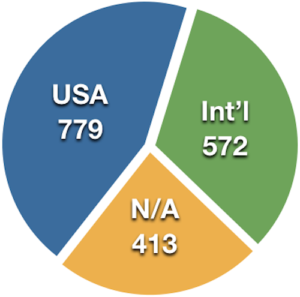 As of December 31, 2018, the PRP Global Database maintains “core data” regarding 1,764 PRP patients, of which 779 (44%) live in the U.S. and 572 (32%) live beyond the U.S. borders. A total of 413 (23%) PRP patient profiles do not include location, e.g., city, state/province, country. LOCATION is important for two reasons:
As of December 31, 2018, the PRP Global Database maintains “core data” regarding 1,764 PRP patients, of which 779 (44%) live in the U.S. and 572 (32%) live beyond the U.S. borders. A total of 413 (23%) PRP patient profiles do not include location, e.g., city, state/province, country. LOCATION is important for two reasons:
❏‰ Help PRP patients identify fellow patients who are literally “down the road”
❏‰ Help PRP patients and advocates organize states, provinces and countries.
UPDATE: As of January 31, 2019, the total number of PRP patient profiles is 1,797 (gain of 33).
“Country” Overview
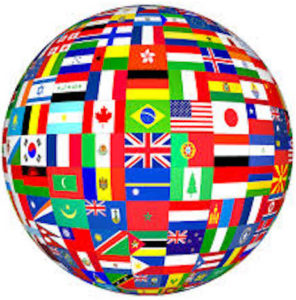 The following table details the distribution of the PRP patient population based on 1,351 PRP patient profiles based on the PRP Global Database as of December 31, 2018. Please note that this list includes 580 PRP patients who are “active and under treatment”, 361 PRP patients “in remission”, and 410 PRP patients who have not yet to share their CURRENT STATUS. The highest concentration of PRP patient profiles includes:
The following table details the distribution of the PRP patient population based on 1,351 PRP patient profiles based on the PRP Global Database as of December 31, 2018. Please note that this list includes 580 PRP patients who are “active and under treatment”, 361 PRP patients “in remission”, and 410 PRP patients who have not yet to share their CURRENT STATUS. The highest concentration of PRP patient profiles includes:
❏‰ United States (779)
❏‰ United Kingdom (136)
❏‰ Australia (101)
❏‰ Canada (72).
“USA by State” Overview
 The “USA by State” table details the PRP patient population in the United States based on 779 PRP patient profiles maintained in the PRP Global Database as of December 31, 2018. Please note that this list includes 347 PRP patients who are “active and under treatment”, 229 “in remission” and as well as 203 who have yet to share their CURRENT STATUS. The highest concentration of PRP patient profiles includes:
The “USA by State” table details the PRP patient population in the United States based on 779 PRP patient profiles maintained in the PRP Global Database as of December 31, 2018. Please note that this list includes 347 PRP patients who are “active and under treatment”, 229 “in remission” and as well as 203 who have yet to share their CURRENT STATUS. The highest concentration of PRP patient profiles includes:
❏‰ California (95)
❏‰ Texas (66)
❏‰ Florida (58)
❏‰ Pennsylvania (36)
❏‰ Virginia (36)
❏‰ New York (33)
❏‰ North Carolina (32)
“Valid Email Address” Overview
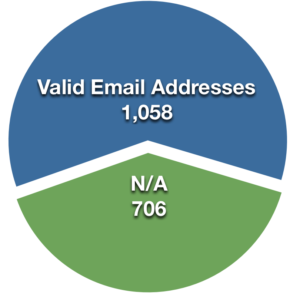 Nearly 60% of the 1,058 PRP patient profiles include a valid email address. Moreover, 554 are also members of the PRP Facebook Support Group. Unfortunately, 706 (40%) have yet to share their email address. Since the summer of 2013 when the PRP Global Database was created, NO email address has been shared with any third party – including PRP researchers. As we say, “We share NUMBERS, not NAMES.
Nearly 60% of the 1,058 PRP patient profiles include a valid email address. Moreover, 554 are also members of the PRP Facebook Support Group. Unfortunately, 706 (40%) have yet to share their email address. Since the summer of 2013 when the PRP Global Database was created, NO email address has been shared with any third party – including PRP researchers. As we say, “We share NUMBERS, not NAMES.
“Onset Date “Overview
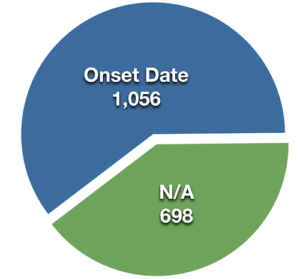 PRP patients and caregivers are quick to remember and share the date a dermatologist rendered the official diagnosis of PRP. In contrast, the first appearance of a PRP-related symptoms often requires probing. The PRP patient profile seeks a month and year. If the patient says “Fall of 2017”, October, 2017 is entered. The Onset Date is essential to document the elapsed time. While 60% of the PRP patient profiles include ONSET DATE, 40% are missing this critical datapoint.
PRP patients and caregivers are quick to remember and share the date a dermatologist rendered the official diagnosis of PRP. In contrast, the first appearance of a PRP-related symptoms often requires probing. The PRP patient profile seeks a month and year. If the patient says “Fall of 2017”, October, 2017 is entered. The Onset Date is essential to document the elapsed time. While 60% of the PRP patient profiles include ONSET DATE, 40% are missing this critical datapoint.
“Onset Age” Overview
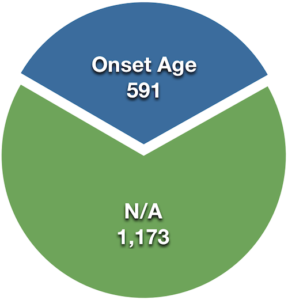 Onset Age is a quick way to determine whether the PRP patient has a diagnosis of Adult Onset PRP or Juvenile Onset PRP. The absence of onset age makes an adult versus juvenile impossible to determine. Only 591 (33%) of the PRP patient profiles include ONSET AGE while 67% are missing this critical datapoint.
Onset Age is a quick way to determine whether the PRP patient has a diagnosis of Adult Onset PRP or Juvenile Onset PRP. The absence of onset age makes an adult versus juvenile impossible to determine. Only 591 (33%) of the PRP patient profiles include ONSET AGE while 67% are missing this critical datapoint.
❏‰ birth to 9: 80
❏‰ 11 to 19: 20
❏‰ 20 to 29: 20
❏‰ 30 to 39: 43
❏‰ 40 to 49: 93
❏‰ 50 to 59: 141
❏‰ 60 to 69: 140
❏‰ 70 to 79: 46
❏‰ 80 to 89: 6 90 to 99: 2
“Current Status” Overview
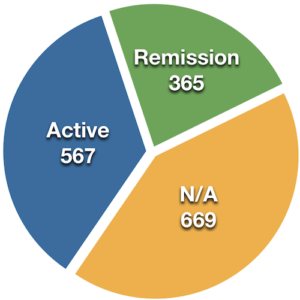 When a PRP patient joins he PRP Facebook Support Group they are immediately classified as “Active”. However, there are many PRP patients identified as “Active” who might be in remission. Conversely, there may be PRP patients listed as “in remission” who have relapsed. Even more disconcerting, no one knows the current status of the 669 who have yet to share that information. Nevertheless, the question is always asked: “What is your current status?”
When a PRP patient joins he PRP Facebook Support Group they are immediately classified as “Active”. However, there are many PRP patients identified as “Active” who might be in remission. Conversely, there may be PRP patients listed as “in remission” who have relapsed. Even more disconcerting, no one knows the current status of the 669 who have yet to share that information. Nevertheless, the question is always asked: “What is your current status?”
“Remission Date” Overview
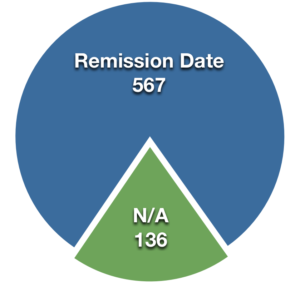 When we have ONSET DATE and REMISSION DATE, the DURATION of a PRP journey can be calculated. For example: my onset date of August 8, 2012, and a remission date of April 8, 2014 reflects a duration of 20 months. However, one of the problems tracking remission-related information is the lack of a universally accepted definition.
When we have ONSET DATE and REMISSION DATE, the DURATION of a PRP journey can be calculated. For example: my onset date of August 8, 2012, and a remission date of April 8, 2014 reflects a duration of 20 months. However, one of the problems tracking remission-related information is the lack of a universally accepted definition.
❏‰ No symptoms with no meds
❏‰ No symptoms with meds
❏‰ Minimal symptoms with meds
❏‰ Minimal symptoms with no meds
For more about remission, go to Chapter 5
“Dermatologist” Overview
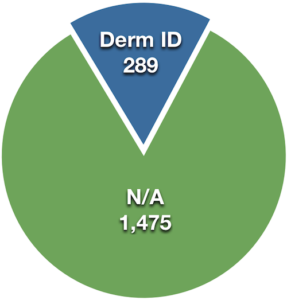 The first global effort to identify PRP-savvy dermatologists began in November 2013 and was posted in the PRP Survival Guide. During PRP Awareness Month (November 2018), the effort was renewed. While PRP patients with GREAT dermatologists were eager to share names and contact information. In contrast, PRP patients lacking a positive experiences with their dermatology were reticent to share. The result: 59% of the PRP patient profiles do not list a dermatologist. Nonetheless, the identification of dermatologists, clinics and teaching hospitals with PRP experience should be prime targets for information gathered by the Global PRP Community.
The first global effort to identify PRP-savvy dermatologists began in November 2013 and was posted in the PRP Survival Guide. During PRP Awareness Month (November 2018), the effort was renewed. While PRP patients with GREAT dermatologists were eager to share names and contact information. In contrast, PRP patients lacking a positive experiences with their dermatology were reticent to share. The result: 59% of the PRP patient profiles do not list a dermatologist. Nonetheless, the identification of dermatologists, clinics and teaching hospitals with PRP experience should be prime targets for information gathered by the Global PRP Community.
“PRP Patient Profiles” Overview
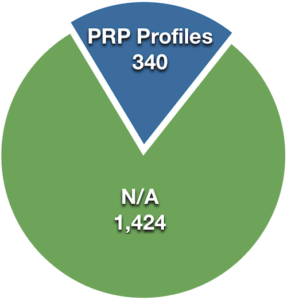 The PRP patient profile is the foundation of the PRP Global Community. The ability of the Global PRP Community to rally around a PRP research project is evidenced by the 572 PRP patients who participated in the recent UCLA PRP Survey. The “core data” we seek includes:
The PRP patient profile is the foundation of the PRP Global Community. The ability of the Global PRP Community to rally around a PRP research project is evidenced by the 572 PRP patients who participated in the recent UCLA PRP Survey. The “core data” we seek includes:
❏‰ Name of patient
❏‰ Location (state/province, country)
❏‰ Email address
❏‰ Onset date (mm/yyyy)
❏‰ Onset age
❏‰ Current status (active/ remission) ❏‰ Remission date (if applicable)
❏‰ Dermatologist(s)
❏½ PRP Database versus Registry
Now it’s your turn. Behold the 2019 PRP Global Census
 A total of 469 PRP patients updated their PRP patient profiles in 2018. If the information is still correct, you do not need to complete an online, 2019 PRP Global Census form.
A total of 469 PRP patients updated their PRP patient profiles in 2018. If the information is still correct, you do not need to complete an online, 2019 PRP Global Census form.
The information we seek in the 2019 PRP Global Census will be used to “whet the appetite of PRP researchers”. We used the PRP Global Database in 2018 to recruit 574 participants in a PRP Research project undertaken by UCLA, USC and Kaiser Permanente.
Thank you in advance for participating in the 2019 PRP Global Census.
